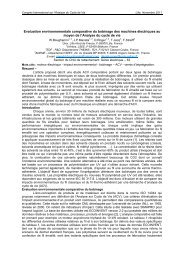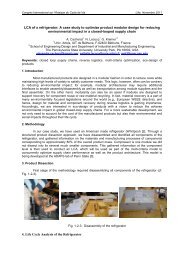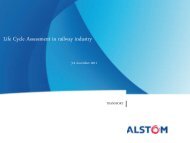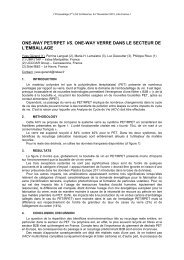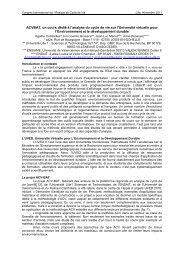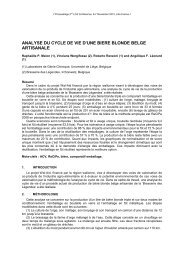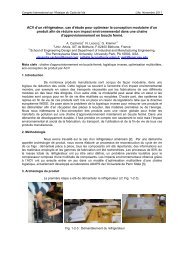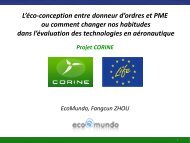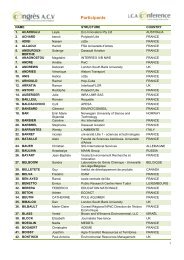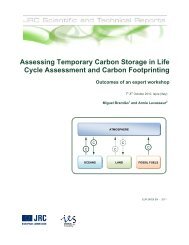Untitled - avniR
Untitled - avniR
Untitled - avniR
You also want an ePaper? Increase the reach of your titles
YUMPU automatically turns print PDFs into web optimized ePapers that Google loves.
Mechanical<br />
recycling<br />
Enregy<br />
recovery<br />
Landfill<br />
Mechanical<br />
recycling<br />
Enregy<br />
recovery<br />
Landfill<br />
Mechanical<br />
recycling<br />
Enregy<br />
recovery<br />
Landfill<br />
Congrès International sur l’Analyse du Cycle de Vie Lille, Novembre 2011<br />
- End-of-life<br />
The results show that the mechanical recycling is more interesting than the energy recovery<br />
approach and the landfill (cf. FIG. 2).<br />
Abiotic depletion potential<br />
(fossil) [MJ]<br />
10<br />
1,5<br />
Global warming potential<br />
[kg CO2-Equiv.]<br />
Water consumption<br />
100%<br />
5<br />
1<br />
Textile insulation production<br />
80%<br />
0<br />
0,5<br />
Classic insulation production<br />
Eutrophication<br />
potential<br />
60%<br />
40%<br />
20%<br />
Energy resources<br />
consumption<br />
-5<br />
-10<br />
0<br />
-0,5<br />
Energy recovery<br />
Energy and steam production<br />
Landfill<br />
0%<br />
-15<br />
-1<br />
NET<br />
Global warming<br />
potential<br />
10<br />
Abiotic depletion potential<br />
(fossil) [MJ]<br />
Abiotic depletion<br />
potential (fossil)<br />
-20<br />
-1,5<br />
5<br />
0<br />
Acidification potential<br />
-5<br />
Sheet n°1<br />
Sheet n°2<br />
Sheet n°3<br />
Sheet n°4<br />
Textile insulation production<br />
Energy recovery<br />
Landfill<br />
Classic insulation production<br />
Energy and steam production<br />
NET<br />
FIG. 1 – Environmental impacts for -10the bed-sheets 1 to 4 FIG. 2 - Influence of the end-of-life of a bed-sheet<br />
-15<br />
Discussions<br />
-20<br />
The results obtained for the bed-sheets 2 and 4 are partly explained by the longer lifetime of these<br />
two articles. In fact, the polyester and the easy-care treatment lead to a better abrasion resistance. For the<br />
bed-sheet n°4 the results are also related to the removal of ironing step during the use phase. Thus,<br />
despite an additional finishing step for the easy-care treatment, there is a reduction of environmental<br />
impacts.<br />
For the end-of-life of bed-sheets, it is more interesting to perform a mechanical recycling rather<br />
than energy recovery approach or landfill. However, only two environmental impacts are studied. It is<br />
necessary to study a larger number of indicators for an overall vision.<br />
The impacts of mechanical recycling are mainly due to the presence of polyester bi-component<br />
used as binder in the production of textile insulation. The negative impact of the binder was also<br />
demonstrated by the study of Murphy and Norton [2].<br />
Conclusions<br />
It is possible to act on all stages of the cycle of a textile product to reduce its environmental impact.<br />
LCA is a tool that enables companies to make the best choices for the design and the production of their<br />
products. With LCA the manufacturers have also a vision of the overall life cycle of the item, and can work<br />
on the end of life for example.<br />
References<br />
[1] European Commission, 2003, Reference document on Best Available Techniques for the<br />
textiles industry, IPPC<br />
[2] Murphy R.J. and A. Norton, 2008, Life cycle assessments of natural fibre insulation materials,<br />
NNFCC<br />
[3] National Renewable Energy Laboratory, 2000, U.S. Life Cycle Inventory (LCI) Database<br />
- 86 -



